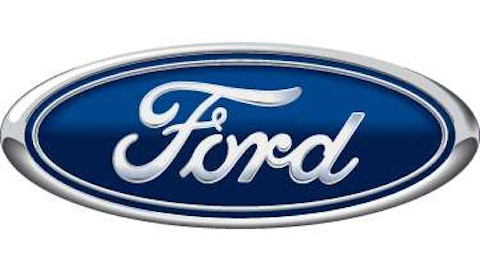
What do auto players say?
Comments from different management teams seem to reaffirm this view, at the very least suggesting stabilization. BorgWarner Inc. (NYSE:BWA) and Delphi Automotive PLC (NYSE:DLPH) noted at Americas Select Conference in London (held in the last week of May) that they see production schedules stabilizing.
Moreover, last week, Ford Motor Company (NYSE:F)’s senior management highlighted the fact that the April Seasonally Adjusted Annual Rate (SAAR) for the 19 markets they track in Europe came in at 13.6 million, slightly above their 2013 guidance range of 13.0 million to 13.5 million. Admittedly, they cautioned that it’s too early to draw conclusions from one month of data, but they believe there is some chance that sales in Western Europe have bottomed, and that sales may stabilize throughout the year, especially as austerity programs are dialed back.
However, although I see some stabilization in Europe, I disagree with the view that a recovery is looming there.
Near-term production schedules appear stable, but Barclays remains below consensus for 2H’13 and 2014. Currently, 2Q Europe light-vehicle production is estimated to be slightly less than 4.8 million units, modestly below the IHS Automotive Research’s estimate of 4.8 million units. However, IHS’ estimates seem to be overoptimistic for the second half of 2013 and full year 2014.
For the second half of 2013, production is estimated to be 8.6 million units (IHS estimates 9 million units). For 2014, production is expected to fall ~900,000 units, light of the IHS estimate of 19.3 million units. Therefore, Barclays doesn’t expect as sharp a rebound as the +600,000 recovery that IHS expects (18.7 million in ’13, 19.3 million in ’14).
April registrations just a mirage!
Don’t be fooled by the positive headline result for April European registrations. Easter landed in April last year, and thus, adjusting for the two additional work days, volumes were in fact down 6.1% on a year-over-year basis in April, which is the worst decline in three months. SAAR for the 27 markets tracked by the European Automobile Manufacturers’ Association (ACEA) was 12.0 million, down 5.7% sequentially, and 11% below the five-year average, implying no sign of the recovery some pundits in the market are suggesting.
While the Street still seems to be skeptical on a potential European production rebound in the next year or so, the signs seem to point to some pricing improvement in the second quarter of 2013– a trend which can be best played through Ford Motor Company (NYSE:F)and General Motors Company (NYSE:GM) , which benefit from price improvements, versus the suppliers, which still face production risk later this year and next.
Investment thesis
BorgWarner Inc. (NYSE:BWA) manufactures a variety of engine and drivetrain components that increase fuel efficiency and reduce emissions, such as turbochargers and automatic transmission components. Demand for BorgWarner’s products is strong, driven by both consumer “pull” and government “push” elements, and will only increase over time as the rising amount of vehicles in emerging markets upwardly pressures fuel prices.
BorgWarner Inc. (NYSE:BWA) already enjoys the second-highest margins in the sector, in part driven by the fact that many of the products it manufactures are of a highly engineered nature, leading to high technical barriers to entry and market concentration. Still, the combination of rapid top-line growth and financial discipline is expected to allow for top-tier operating margin expansion. High European exposure is concerning in a downside scenario, but is offset in part by ideal customer mix within Europe and diversification into higher growth Asian markets.



